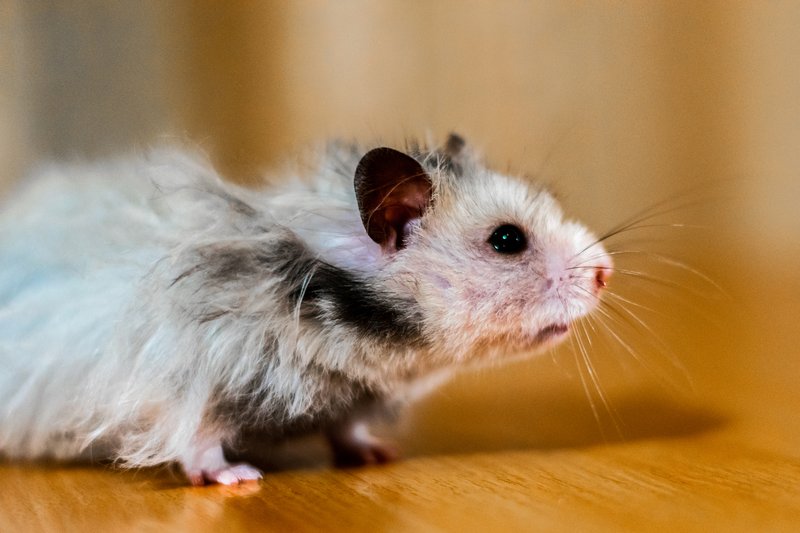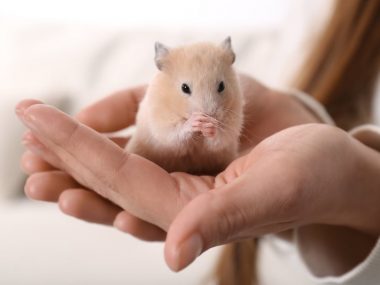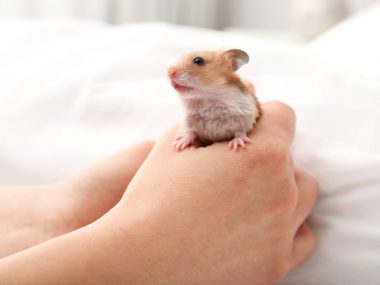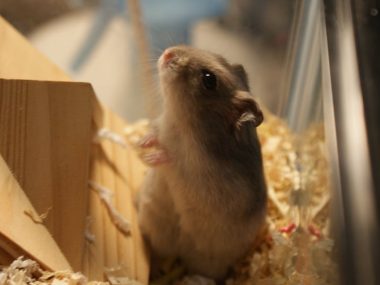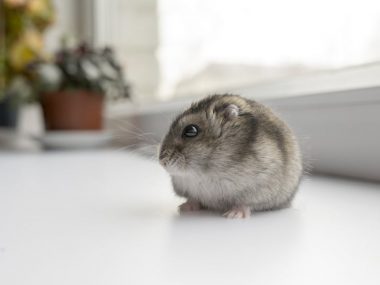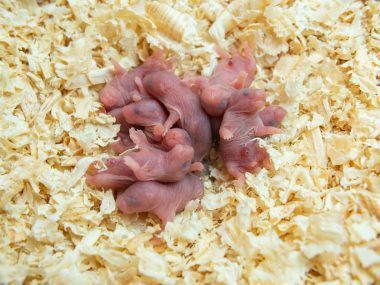One of the main attractants to hamster owners is the hamster’s adorable teddy-bear looks; they’re so snuggly and cute with all that fur! But what can you do if your formerly fluffy hamster starts losing hair faster than Donald Trump?
A hamster may lose hair due to pathological or non-pathological causes. A veterinarian should examine all hamsters with excessive hair loss; depending on the diagnosis, treatment may include medication, diet, separation of cage mates, improved hygiene, and parasite control.
All is good with the world until you notice bald spots on your dwarf hamster. To your horror, you realize the bald dots are spreading! What is the owner of a balding hamster supposed to do? Is there any way to stop your hamster from losing even more hair and maybe even reverse the process?
Table of Contents
Why Is My Hamster Losing Hair?
Alopecia is the scientific term for abnormal hair loss resulting in balding patterns that may cause your hamster to:
- Go completely bald
- Develop regional baldness, e.g., the entire belly or hindquarters
- Have bald spots, patches, or dots.
Alopecia is distinguishable from healthy hair loss based on the amount of hair lost, overall balding or thinning of the hamster’s hair and general coat condition.
Hamsters routinely shed hair, particularly during spring when they lose their winter coat. While your hamster’s summer coat may seem slightly thinner than their heavy winter coat, it should not result in bald patches.
The causes for balding, bald patches, and excessive hair loss in hamsters, are divided into two broad categories: pathological and non-pathological.
Common pathological causes for balding in hamsters include:
- Dermatophytosis (i.e., fungal infection of the skin) such as ringworm
- Ticks, fleas, and other ectoparasite infestations
- Demodicosis, i.e., mange especially in older or immunocompromised hamsters
- T-Cell Lymphoma in the skin
Rare pathological causes for balding in hamsters include:
- Tumors in the adrenal gland
- Hyperadrenocorticism, e.g., Cushing’s disease
- Thyroid gland imbalance
- Chronic renal issues, i.e., problems with the kidneys
Non-pathological causes of balding in hamsters include:
- Dietary imbalances, e.g., not enough protein (less than 16% dietary protein) or too much iron
- Barbering by cage mates, i.e., the hamster’s cage mates may chew or excessively groom each other
- Wounds and abscesses
- Mechanical hair removal from rubbing on parts of the cage
- Stress
- Life-stage, e.g., a lactating female hamster may lose her belly hair while feeding her pups.
Do Hamsters Lose Hair From Stress?
Stress is rarely a primary cause of hair loss in hamsters. However, this does not mean that stress does not play a role in hamster alopecia.
Stress may cause your hamster to go bald due to:
- Repetitive stress-triggered behaviors
- Aggression between cagemates
- A secondary pathology that occurred due to the hamster’s stress-weakened immune system
Stressed hamsters will often demonstrate excessive burrowing or attempts to escape their cage by sticking their noses through the cage bars. The mechanical friction of the cage bars will cause the hair on the hamster’s nose and face to start falling out.
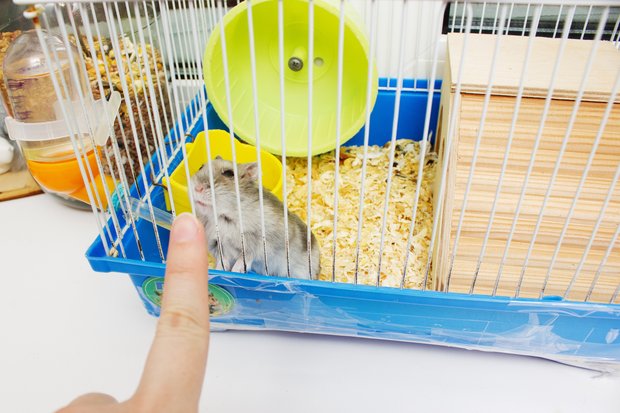
Additionally, stress may cause cage mates to attack or wound each other. The area around the wound often becomes inflamed and damaged, resulting in localized hair loss.
Stress causes an elevation in cortisol, a hormone with an immunosuppressing effect, i.e., a hamster’s immune system is made weaker by acute or chronic stress. Chronic stress is a significant risk factor for developing conditions such as demodectic mange, a pathology characterized by balding and scaly skin.
How Can I Help Stop My Hamster Losing Hair?
Owners should take all hamsters with excessive hair loss, bald spots, or regions to the veterinarian to be examined.
In most cases, treatment of alopecia in hamsters is effective and straightforward IF the condition is treated during the early stages.
How Do Vets Diagnose The Cause Of You Hamster’s Hair Loss?
To diagnose your hamster’s alopecia, the veterinarian will:
- Ask for a complete history of your hamster’s health, age, and behavior
- Ask about what type of food your hamster is eating, and if you have noticed any changes in your hamster’s eating habits
- Examine the balding pattern, i.e., where your hamster is going bald and how big the bald patch is
- Examine your hamster’s physical condition and coat quality
- Examine your hamster’s skin, particularly in the balding areas
Depending on the findings of the clinical history and physical examination, the veterinarian may also decide to take skin scrapes, as well as hair, blood, and stool samples for further investigation.
How Do You Treat Hair Loss In Hamsters?
It is essential to note that excessive hair loss in hamsters is a symptom and not a disease in itself. Thus, the treatment for balding in hamsters depends on the underlying cause for the hair loss.
Non-pathological causes for hair loss in hamsters are usually treated by changing your hamster’s diet, cage mates, cage space, treating wounds, and managing your hamster’s stress levels.
Non-pathological alopecia in hamsters usually has a good prognosis, and if treated early enough, your hamster’s fur should grow back.
Not all pathological causes of hamster alopecia are treatable. When deciding whether to treat your hamster, it is essential to consider your:
- Hamster’s age: older hamsters may struggle to deal with the treatment, and your veterinarian may advise euthanasia as a kinder choice.
- Hamster’s general condition and quality of life: a hamster in poor condition will have a worse prognosis than one in good condition; are you extending your hamster’s suffering on a slim chance that they might survive?
- Disease progression and prognosis: not all diseases are treatable, e.g., cancer
If you and your veterinarian agree that treating your hamster is a viable option with a good prognosis, your veterinarian may prescribe (depending on the diagnosis):
- Oral medication
- Medicated shampoos
- Topical antifungal creams
- Antibiotic creams
- Dietary changes
- Improved hygiene practices
- Anti-tick and flea shampoos or powders
It is crucial to strictly follow your veterinarian’s instructions on dosage, frequency, and duration of treatment. Owners who decide to stop treatment early or underdose their hamster may cause more damage as the hamster’s condition mutates into a treatment-resistant version.
Conclusion
While Dwayne Johnson, Jason Stratham, and Vin Diesel have owned their baldness, building entire careers out of their shiny-headed handsomeness, there is no need for your hamster to do the same!
Most cases of abnormal hair loss in hamsters can be quickly resolved with prompt treatment, balanced diets, good internal and external parasite control, and adherence to effective hygiene principles.
A small subset of conditions causing alopecia in hamsters has a poor prognosis. These treatment-resistant conditions include tumors in the renal glands, thyroid gland imbalances, T-cell lymphoma, and renal issues.
References
https://www.oxfordlearnersdictionaries.com/definition/english/alopecia?q=alopecia
https://www.msdvetmanual.com/all-other-pets/hamsters/disorders-and-diseases-of-hamsters
https://www.isvma.org/wp-content/uploads/2017/10/SMALL_RODENTS_Common_Diseases.pdf
https://www.veterinary-practice.com/article/demodicosis-in-the-hamster
https://www.ncbi.nlm.nih.gov/pmc/articles/PMC1790585/
https://veterinarypartner.vin.com/default.aspx?pid=19239&catId=102922&id=4951547 https://www.petmd.com/exotic/conditions/skin/c_ex_hm_alopecia
